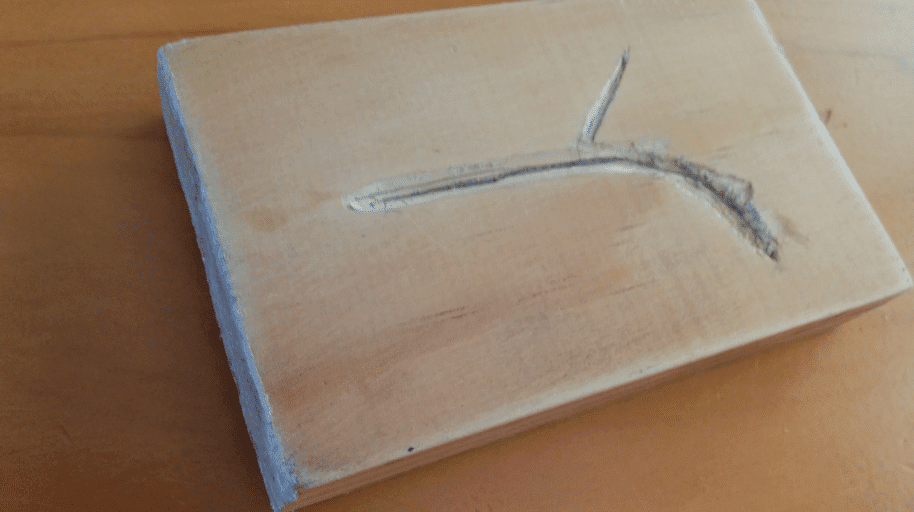Around the hillside of the sheep farm where I was raised were grooves worn into the soil by hundreds of sheep following each other. It was the easiest route.
I also have routes in my thinking patterns that have become ruts. Familiar paths that have been worn deep into my thinking.
A thought gets triggered, then another one and another one. Then within a few milliseconds, you are down in that old familiar cesspool of negativity.
Groove Board
Years ago, I attended the Living Wisdom School of Counselling, run by David Riddell.
He gave us all a piece of wood, and on this small flat piece of timber were two grooves, one larger than the other. The larger carved groove went down, and the smaller one went up.
He then got us to trace a pen along the larger well-worn route. It had been carved out deep through many trips. You could feel just how easy it was to travel this route. This is the thinking patterns that we develop over many excursions.
Just as it started to taper down, there was the smaller groove moving up.
When your pen touched the new groove, you noticed that it was quite shallow and that you had to physically raise your pen to achieve the change of direction. It took an effort to make the change.
Four lessons learned
- A change in our long-held thinking patterns is possible
- It takes a thinking step to make that change
- A habit of taking that step is needed.
- That habit requires calorific energy.
Over time, as I devoted a few calories of brainpower to the change, the new groove got deeper and deeper. But, of course, the old groove will always be there, but with time cobwebs, as such, will grow over it with lack of use.
7 Steps to change your thinking patterns
- Take note of those lightbulb moments.
Lightbulb moments, those sudden moments of understanding and realization that shout ‘This is for you.’
It could be a verse of scripture, a quote, something shared by a therapist, pastor, or spiritual director. A counselor I know takes notes during the session and then gives a copy to the client.
The client can then go away with the notes and reflect over them, looking for nuggets. Write those moments down. Grab them before they fly away. They are invitations to step into a new reality. - Form these moments into a ‘Go this way’ step.
So back to our Groove board.
Imagine that you are going down that well-worn path and then on your left is a slight upward step.
Above the step is a signpost with two pointing signs. The righthand sign has written ‘Old way.’ On the left, it has ‘New Way’ and another sign under it saying ‘Go This Way.’
That step on the left, small but deeply significant, is the step you need to make in your brain. It goes up because it requires energy. The step will be the verse, quote, ah-ha moment, etc.
Here are some examples
What I focus on gets me. Focus on the negatives/challenges will always take me down. Focus on the positives/ good things will always give me hope.
“Be strong and do the work.” 1 Chron. 28: 9-10
If God is for me, I need to be for myself - Create yourself a Groove Board.
It is powerful for the brain to have something tangible that you can hold and feel while doing this exercise. That there is a physicality to what you are doing.
Those little neuro connections you are making are real and tangible. So the use of something physically tangible reinforces to your brain circuity that this is a tangible activity you’re doing.
I have made mine out of wood, but you can easily make one out of plastic. Just find some firm but soft plastic. Get a pen and mark a straight line with a curve that goes down. Run your pen firmly over and over it until the groove runs deep. Then create another groove, shallower this time where the curve is just starting to go down. Have this curve going upwards.
You now have a Groove board. Use it as a bookmark in your thinking compass. - Collate your”Go this way step” into your Thinking Compass.
I use a small notebook for my thinking compass.
You could use your cell phone and record your steps there, but I prefer writing them by hand.
There is a physicality of writing that seems to begin the anchoring of these steps into the brain.
- Keep this Thinking Compass close at hand.
Put it in your purse, briefcase, the back pocket so you can grab it quickly at any time.
During the day, those old thinking habits can roll in like a bank of fog. You need your thinking compass to get you out of it.
Read more here. How to Develop a Compass for the Brain
- Read those steps at least two times a day for 52 days.
Your brain won’t change overnight, but it will with repeated exposure of it to the truth.
Why 52 days? Various estimates have been made about how many days it takes to form new habits. Some say 66 days; others suggest 21 days. I’m going to suggest 52.
Read more here. 52 Days to Better Mental Health
- Keep adding new”Go this way step”.
As you go along, you will find new insights and thinking steps. Add these into your thinking compass and nourish the brain with the truth.
Through consistent, focused attention and effort using a thinking compass, our thinking patterns can change.
Consider also reading
- Seven Steps to Change your Default Thinking Patterns
- 5 Steps to take when the Panic button has been pushed
- How does Reading the Bible help my Mental Health?
- 14 Proven Bible Verses to Help Your Mental Health
Quotes to consider
- The brain is a far more open system than we ever imagined, and nature has gone very far to help us perceive and take in the world around us. It has given us a brain that survives in a changing world by changing itself. Norman Doidge, The Brain That Changes Itself
- There is absolutely no substitute for repeating the right insight when you come under pressure to revert to the old ways. Use it or lose it. D. Riddell
- We are what we repeatedly do. Excellence, then, is not an act, but a habit. Aristotle
- The secret of your future is hidden in your daily routine. Mike Murdoch
Questions to answer and leave a comment below
- How might prayer be used to help change our thinking patterns?
- What is the greatest obstacle to overcome when we consider making a long-term change in our thinking?
- What insights, quotes, verses have you used to see a change in your thinking? How have they changed you?
Barry Pearman





